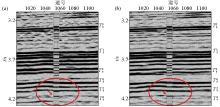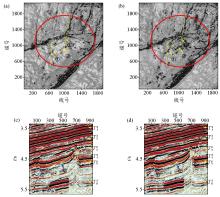|
|
|
| Application of an internal multiples suppression technique combined with modeling method and adaptive matching subtraction:A case study of the Yubei area in the Tarim Basin |
PEI Yun-Long( ), YANG Jin-Long( ), YANG Jin-Long( ), ZHOU Yan, SONG Hui ), ZHOU Yan, SONG Hui |
| Geophysical Research Institute Co.,Ltd.,SINOPEC,Nanjing 211103,China |
|
|
|
|
Abstract Areas with low exploration degrees in the Tarim Basin exhibit intricate seismic-geologic conditions and extensively developed multiples.The internal multiples generated by strong reflection interfaces involving Paleozoic gypsum rocks undermine the imaging of the Ordovician stratigraphic information,resulting in vague images for Ordovician fractured-vuggy carbonate reservoirs and thus affecting stratigraphic interpretation.Accurate prediction and suppression of internal multiples in the Yubei area is challenging,thus restricting the deployment of oil and gas exploration in the area.The conventional prediction method for internal multiples is computationally intensive and ineffective.Hence,this study proposed an internal multiples suppression technique combined with the modeling method and adaptive matching subtraction.Based on the principles of internal multiples prediction and the forward modeling results,the proposed technique takes the main reflection interfaces generating internal multiples as the model layers and follows the approach of layer-by-layer prediction and suppression.Finally,it employs adaptive matching subtraction for the suppression of internal multiples.As demonstrated by the processing results of actual data,the proposed technique can effectively predict and suppress the dominant internal multiples to eliminate their interference effects.It solves the problems of layer-crossing phenomenon and flat formation occurrence,improving the imaging accuracy of formation structures,faults,and fractured-vuggy reservoirs.
|
|
Received: 14 December 2023
Published: 26 February 2025
|
|
|
|
|
|

|
SRME predicts the path of internal multiples
|

|
Extended SRME predicts the path of internal multiples
|

|
Experimental study on interface model of strong waveimpedance with gypsum rock
a—velocity model;b—simulated record migration profile;c—after multiple wave suppression in this paper
|

|
Typical seismic migration imaging profile and schematic diagram of the main internal multiples generated in the Yubei area
a—migration imaging profile containing multiple waves and a schematic diagram of the propagation of internal multiples;b—the main internal multiples profiles generated
|

|
Identification and analysis of internal multiples by VSP data
a—corridor superposition analysis to identify internal multiples; b—well stratified calibration to identify internal multiples
|
T 3 0multiples generated;c— multiples generated;d— multiples generated
">

|
Imaging profile of predicted internal multiples by model method
a—primary wave data;b— multiples generated;c— multiples generated;d— multiples generated
|
T 3 0and multiples generated;d—after multiples suppression
">

|
Analysis of the effect of adaptive subtraction suppression of multiple waves using model method
a—stacked profile; b—before multiples suppression;c—predicted and multiples generated;d—after multiples suppression
|
T 3 0 multiples generated;c—predicted multiples generated;d—after multiples suppression
">

|
CMP track set display of multiples model before and after adaptive subtracting multiple waves and layer by layer prediction
a—before multiples suppression;b—predicted multiples generated;c—predicted multiples generated;d—after multiples suppression
|

|
Velocity spectra and trace sets before(a) and after(b) internal multiples suppression
|

|
Comparison of migration profiles before and after internal multiples suppression and its autocorrelation analysis profiles
a—before internal multiples suppression;b—after internal multiples suppression;c—autocorrelation profile before interlayer multiples suppression;d—autocorrelation profile after interlayer multiples suppression
|

|
Comparison of migration profiles before(a) and after(b) internal multiples suppression
|

|
Comparison of AVO properties of imaging profiles and their gathers before and after internal multiples suppression
a—profile before internal multiples suppression;b—gather before internal multiples suppression;c—AVO analysis of the gathers before internal multiples suppression;d—profile after internal multiples suppression;e—gather after internal multiples suppression;f—AVO analysis of the gathers after internal multiples suppression
|

|
Comparison of VSP well vibration matching relationship before(a) and after(b) internal multiples suppression
|
T 7 4 layers before and after internal multiples suppression
a—coherent amplitude properties before internal multiples suppression;b—coherent amplitude properties after internal multiples suppression;c—migration imaging profile before internal multiples suppression;d—migration imaging profile after internal multiples suppression
">

|
Comparison of coherence amplitude properties and corresponding migration imaging profiles along layers before and after internal multiples suppression
a—coherent amplitude properties before internal multiples suppression;b—coherent amplitude properties after internal multiples suppression;c—migration imaging profile before internal multiples suppression;d—migration imaging profile after internal multiples suppression
|
| [1] |
贺紫林, 李振春, 李志娜, 等. 基于反馈迭代模型的多次波压制方法综述[J]. 物探与化探, 2022, 46(2):275-284.
|
| [1] |
He Z L, Li Z C, Li Z N, et al. A review of multiple suppression methods based on feedback iteration model[J]. Geophysical and Geochemical Exploration, 2022, 46(2):275-284.
|
| [2] |
沈向存, 李宗杰, 姜忠正. 巴麦地区奥陶系低信噪比资料层间多次波叠后压制技术及应用[J]. 石油物探, 2022, 61(3):483-489.
|
| [2] |
Shen X C, Li Z J, Jiang Z Z. Post-stack suppression technology for internal multiples and its application in low signal-to-noise ratio data of Ordovician Bamai Area in Tarim Basin,China[J]. Geophysical Prospecting for Petroleum, 2022, 61(3):483-489.
|
| [3] |
裴云龙, 杨金龙, 蒋波, 等. 基于层控数据驱动的层间多次波预测与压制方法及其应用[J]. 石油物探, 2023, 62(5):912-924.
|
| [3] |
Pei Y L, Yang J L, Jiang B, et al. Layer-controlled data-driven method for predicting and suppressing internal multiples and its applications[J]. Geophysical Prospecting for Petroleum, 2023, 62(5):912-924.
|
| [4] |
徐强, 徐爽, 王炜, 等. 基于格林函数的层间多次波预测[J]. 物探与化探, 2022, 46(6):1512-1517.
|
| [4] |
Xu Q, Xu S, Wang W, et al. Prediction of interbed multiples based on the Green’s function[J]. Geophysical and Geochemical Exploration, 2022, 46(6):1512-1517.
|
| [5] |
杨金龙, 朱立华. 逆散射级数层间多次波压制方法及其应用[J]. 石油物探, 2018, 57(6):853-861.
|
| [5] |
Yang J L, Zhu L H. Inverse scattering series internal multiple attenuation method and its application[J]. Geophysical Prospecting for Petroleum, 2018, 57(6):853-861.
|
| [6] |
李东庆, 袁刚, 杨金龙, 等. 逆散射级数和抛物线Radon变换联合的层间多次波压制策略[J]. 石油物探, 2021, 60(2):295-303,341.
|
| [6] |
Li D Q, Yuan G, Yang J L, et al. Suppression of internal multiples by combining inverse scattering series and the Radon transform[J]. Geophysical Prospecting for Petroleum, 2021, 60(2):295-303,341.
|
| [7] |
Jakubowicz H. Wave equation prediction and removal of internal multiples[C]// Expanded Abstracts of 68th Annual Internate SEG Mtg,1998:1527-1530
|
| [8] |
弗斯丘尔. 地震多次波去除技术的过去、现在和未来[M].陈浩林,张保庆,刘军,等译. 北京: 石油工业出版社,2010:90-147.
|
| [8] |
Verschuur D J. Seismic multiple removal techniques past,present and future[M].Chen H L,Zhang B Q,Liu J,et al. Trans.Beijing: Petroleum Industry Press,2010:90-147.
|
| [9] |
Berkhout A J, Verschuur D J. Removal of internal multiples with the common-focus-point (CFP) approach:Part 1—Explanation of the theory[J]. Geophysics, 2005, 70(3):V45-V60.
|
| [10] |
Verschuur D J, Berkhout A J. Removal of internal multiples with the common-focus-point (CFP) approach:Part 2—Application strategies and data examples[J]. Geophysics, 2005, 70(3):V61-V72.
|
| [11] |
李钟晓, 高好天, 陈鑫泽, 等. 基于3D匹配滤波器和伪地震数据算法的多次波自适应相减方法[J]. 石油地球物理勘探, 2020, 55(3):530-540.
|
| [11] |
Li Z X, Gao H T, Chen X Z, et al. Multiple adaptive subtraction method based on 3D matched filter and pseudo-seismic data algorithm[J]. Oil Geophysical Prospecting, 2020, 55(3):530-540.
|
| [12] |
张宏智, 王大龙, 张春牛, 等. 基于地震信号相似性的S变换域多次波压制技术[J]. 物探与化探, 2023, 47(1):208-216.
|
| [12] |
Zhang H Z, Wang D L, Zhang C N, et al. Multiple suppression in the S-transform domain based on the similarity of seismic signals[J]. Geophysical and Geochemical Exploration, 2023, 47(1):208-216.
|
| [13] |
刘小舟, 胡天跃, 刘韬, 等. 数据增广的编解码卷积网格地震层间多次波压制方法[J]. 石油地球物理勘探, 2022, 57(4):757-767.
|
| [13] |
Liu X Z, Hu T Y, Liu T, et al. Seismic internal multiple suppression method with encoder-decoder convolution network based on data augmentation[J]. Oil Geophysical Prospecting, 2022, 57(4):757-767.
|
| [14] |
Yu S W, Ma J W, Wang W L. Deep learning for denoising[J]. Geophysics, 2019, 84(6):V333-V350.
|
| [15] |
Li Z X, Sun N N, Gao H T, et al. Adaptive subtraction based on U-net for removing seismic multiples[J]. IEEE Transactions on Geoscience and Remote Sensing, 2021, 59(11):9796-9812.
|
| [16] |
姜博午, 刘金朋, 陆文凯. 基于伪地震数据模式学习的多次波自适应相减方法[J]. 石油物探, 2022, 61(3):423-432,443.
|
| [16] |
Jiang B W, Liu J P, Lu W K. Adaptive multiple subtraction based on pattern-learning method using pseudo-seismic data[J]. Geophysical Prospecting for Petroleum, 2022, 61(3):423-432,443.
|
| [17] |
甘利灯, 戴晓峰, 徐右平, 等. 处理解释一体化的层间多次波识别与压制——以四川盆地高石梯—磨溪地区灯影组为例[J]. 石油物探, 2022, 61(3):408-422.
|
| [17] |
Gan L D, Dai X F, Xu Y P, et al. Recognition and suppression of interlayer multiples based on integration of processing and interpretation:A case study of Dengying Formation in Gaoshiti-Moxi Area,Sichuan Basin[J]. Geophysical Prospecting for Petroleum, 2022, 61(3):408-422.
|
| [1] |
LIAO Zhen, MA Ji-Tao, CHEN Xiao-Hong, LI Wen-Jin. A Marchenko theory-based method for internal multiple suppression[J]. Geophysical and Geochemical Exploration, 2025, 49(1): 52-62. |
| [2] |
WEI Zi-Xin, LI Hui, WEI Yang, REN Liang-Liang, WEI Jiang, WANG Xu, YU Bin, WANG Jun, PENG Wei, WANG Xi-Jun, XIE Zi-Chen, JIA Jin-Dian, YAO Yue-Wen, AN Na. The indicators of tectonic superimposed halo for prediction and discrimination of denudation degree of deep and peripheral blind ore deposits of hydrothermal deposits and their application effect[J]. Geophysical and Geochemical Exploration, 2025, 49(1): 14-21. |
|
|
|
|

